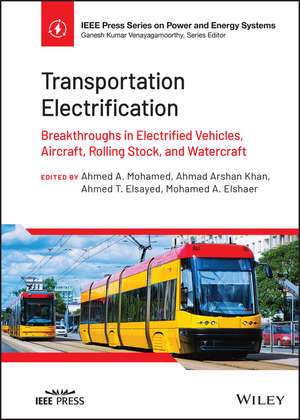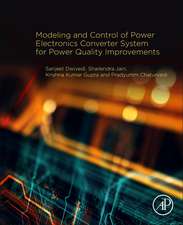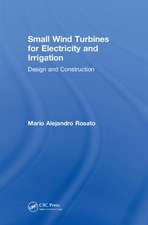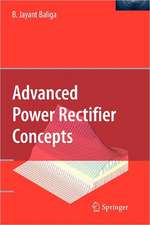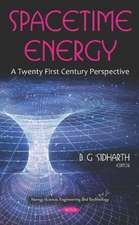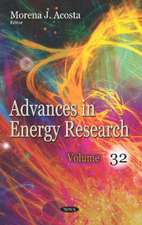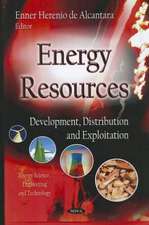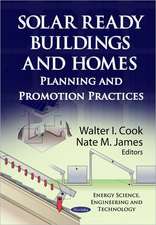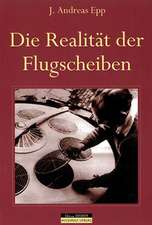Transportation Electrification – Breakthroughs in Electrified Vehicles, Aircraft, Rolling Stock, Watercraft: IEEE Press Series on Power and Energy Systems
Autor AA Mohameden Limba Engleză Hardback – 2 ian 2023
In Transportation Electrification, an accomplished team of researchers and industry experts delivers a unique synthesis of detailed analyses of recent breakthroughs in several modes of electric transportation and a holistic overview of how those advances can or cannot be applied to other modes of transportation. The editors include resources that examine electric aircraft, rolling stock, watercraft, and vehicle transportation types and comparatively determine their stages of development, distinctive and common barriers to advancement, challenges, gaps in technology, and possible solutions to developmental problems.
This book offers readers a breadth of foundational knowledge combined with a deep understanding of the issues afflicting each mode of transportation. It acts as a roadmap and policy framework for transportation companies to guide the electrification of transportation vessels.
Readers will benefit from an overview of key standards and regulations in the electrified transportation industry, as well as:
- A thorough introduction to the various modes of electric transportation, including recent advances in each mode, and the technological and policy challenges posed by them
- An exploration of different vehicle systems, including recent advanced in hybrid and EV powertrain architectures and advanced energy management strategies
- Discussions of electrified aircraft, including advanced technologies and architecture optimizations for cargo air vehicle, passenger air vehicles, and heavy lift vertical take-off and landing craft
- In-depth examinations of rolling stock and watercraft-type vehicles, including various system architectures and energy storage systems relevant to each
Din seria IEEE Press Series on Power and Energy Systems
- 24%
 Preț: 652.67 lei
Preț: 652.67 lei - 24%
 Preț: 609.53 lei
Preț: 609.53 lei - 19%
 Preț: 521.21 lei
Preț: 521.21 lei - 24%
 Preț: 784.16 lei
Preț: 784.16 lei - 24%
 Preț: 1053.86 lei
Preț: 1053.86 lei - 9%
 Preț: 809.68 lei
Preț: 809.68 lei - 9%
 Preț: 831.27 lei
Preț: 831.27 lei - 9%
 Preț: 888.01 lei
Preț: 888.01 lei - 9%
 Preț: 950.76 lei
Preț: 950.76 lei - 9%
 Preț: 869.23 lei
Preț: 869.23 lei - 9%
 Preț: 1196.97 lei
Preț: 1196.97 lei - 9%
 Preț: 849.90 lei
Preț: 849.90 lei - 9%
 Preț: 1008.39 lei
Preț: 1008.39 lei - 8%
 Preț: 654.00 lei
Preț: 654.00 lei - 8%
 Preț: 633.18 lei
Preț: 633.18 lei - 9%
 Preț: 823.81 lei
Preț: 823.81 lei - 9%
 Preț: 759.78 lei
Preț: 759.78 lei - 9%
 Preț: 855.00 lei
Preț: 855.00 lei - 9%
 Preț: 972.84 lei
Preț: 972.84 lei - 9%
 Preț: 1023.14 lei
Preț: 1023.14 lei - 9%
 Preț: 758.19 lei
Preț: 758.19 lei - 9%
 Preț: 946.67 lei
Preț: 946.67 lei - 9%
 Preț: 1002.09 lei
Preț: 1002.09 lei - 8%
 Preț: 648.70 lei
Preț: 648.70 lei - 9%
 Preț: 1077.09 lei
Preț: 1077.09 lei - 9%
 Preț: 1118.73 lei
Preț: 1118.73 lei - 9%
 Preț: 1017.31 lei
Preț: 1017.31 lei - 9%
 Preț: 814.32 lei
Preț: 814.32 lei - 9%
 Preț: 830.83 lei
Preț: 830.83 lei - 9%
 Preț: 834.87 lei
Preț: 834.87 lei - 9%
 Preț: 893.28 lei
Preț: 893.28 lei - 9%
 Preț: 929.27 lei
Preț: 929.27 lei - 9%
 Preț: 1301.39 lei
Preț: 1301.39 lei - 9%
 Preț: 855.70 lei
Preț: 855.70 lei - 9%
 Preț: 781.26 lei
Preț: 781.26 lei - 9%
 Preț: 1009.20 lei
Preț: 1009.20 lei - 9%
 Preț: 886.41 lei
Preț: 886.41 lei - 9%
 Preț: 730.17 lei
Preț: 730.17 lei - 9%
 Preț: 822.19 lei
Preț: 822.19 lei - 9%
 Preț: 963.72 lei
Preț: 963.72 lei - 9%
 Preț: 726.13 lei
Preț: 726.13 lei - 9%
 Preț: 953.44 lei
Preț: 953.44 lei - 9%
 Preț: 851.69 lei
Preț: 851.69 lei - 9%
 Preț: 1200.59 lei
Preț: 1200.59 lei - 9%
 Preț: 947.55 lei
Preț: 947.55 lei - 9%
 Preț: 777.30 lei
Preț: 777.30 lei - 9%
 Preț: 715.62 lei
Preț: 715.62 lei - 9%
 Preț: 786.64 lei
Preț: 786.64 lei - 9%
 Preț: 962.47 lei
Preț: 962.47 lei - 9%
 Preț: 810.41 lei
Preț: 810.41 lei
Preț: 775.33 lei
Preț vechi: 852.01 lei
-9% Nou
Puncte Express: 1163
Preț estimativ în valută:
148.37€ • 153.97$ • 124.02£
148.37€ • 153.97$ • 124.02£
Carte tipărită la comandă
Livrare economică 18 martie-01 aprilie
Preluare comenzi: 021 569.72.76
Specificații
ISBN-13: 9781119812326
ISBN-10: 1119812321
Pagini: 560
Dimensiuni: 178 x 254 x 33 mm
Greutate: 1.18 kg
Editura: Wiley
Seria IEEE Press Series on Power and Energy Systems
Locul publicării:Hoboken, United States
ISBN-10: 1119812321
Pagini: 560
Dimensiuni: 178 x 254 x 33 mm
Greutate: 1.18 kg
Editura: Wiley
Seria IEEE Press Series on Power and Energy Systems
Locul publicării:Hoboken, United States
Cuprins
About the Editors xvii
List of Contributors xix
Introduction xxiii
1 Electrical Machines for Traction and Propulsion Applications 1
Ayman M. EL-Refaie
1.1 Introduction 1
1.2 Light-Duty Vehicles 1
1.3 Medium- and Heavy-Duty Vehicles 7
1.4 Off-Highway Vehicles 9
1.5 Locomotives 9
1.6 Ship Propulsion 10
1.7 High Specific Torque/Power Electrical Machines 13
1.7.1 Electrical Machines for Land Vehicles 13
1.7.2 Electrical Machines for Aerospace Applications 15
1.7.3 Key System Tradeoffs and Considerations 21
1.7.3.1 Specific Power vs Efficiency 21
1.7.3.2 Fault Tolerance 21
1.7.3.3 System Voltage 21
1.7.3.4 Machine Controllability 22
1.8 How Does the Future Look Like? 22
References 25
2 Advances and Developments in Batteries and Charging Technologies 27
Satish Chikkannanavar and Gunho Kwak
2.1 Introduction 27
2.2 Advances in Cathodes/Anodes Covering Energy Density Increase for EV Applications 27
2.2.1 Cathode Challenges for High Energy Density 28
2.2.2 Anode Challenges for High Energy Density 30
2.3 High Power/Energy Cell Designs for xEVs 31
2.4 Post Li-Ion Batteries: Solid-State Batteries 32
2.4.1 Roadmap and Collaborative Relationships 33
2.4.2 Current Development Status and Key Challenges 33
2.5 Advances in Charging Batteries 36
2.5.1 Methods of Fast Charging Batteries 36
2.5.2 Li Plating Effects 37
2.5.3 Overcharge Induced Thermal Runaway 38
2.6 Degradation Considerations 40
2.7 Future Outlook 42
Acronyms 43
References 43
3 Applications of Wide Bandgap (WBG) Devices in the Transportation Sector. Recent Advances in (WBG) Semiconductor Material (e.g. Silicon Carbide and Gallium Nitride) and Circuit Topologies 47
Amir Ranjbar
3.1 History of Semiconductor Technology Evolution 47
3.2 Semiconductor Technologies for Transportation Electrification 49
3.2.1 Trends in Transportation Electrification 49
3.3 Challenges Associated with GaNs in Practical Applications 53
3.3.1 Device Physics Level Challenges with GaNs 53
3.3.1.1 Electron Trapping 53
3.3.1.2 Gate Edge Degradation 54
3.3.1.3 Punch Through Current 54
3.3.1.4 Substrate Choice 54
3.3.2 Application Level Challenges with GaNs 55
3.3.2.1 GaN's Narrow Gate Voltage Margin 55
3.3.2.2 dv/dt Immunity and False Turn-On in GaN Devices 57
3.3.2.3 di/dt Immunity in GaNs 57
3.4 SiC-MOSFET Challenges in Transportation Electrification 58
3.4.1 Low Gain of SiC-MOSFETs 58
3.4.2 Fault Detection in SiC-MOSFETs 59
3.4.3 Driving SiC-MOSFETs 60
3.4.4 Maximum Gate Voltage Swing in SiC-MOSFETs 60
3.4.5 Layout Considerations 61
3.5 Advanced Power Module Packaging to Accommodate WBG Devices 61
3.5.1 Advanced Substrate Materials 63
3.5.2 Advanced Die Attach Methods 64
3.5.3 Interconnection 64
3.5.4 Advanced Encapsulation Materials 67
3.5.5 Advanced Cooling Methods 68
3.6 Summary 69
References 70
4 An Overview of Inductive Power Transfer Technology for Static and Dynamic EV Battery Charging 73
Ahmed A. S. Mohamed, Ahmed A. Shaier, and Hamid Metwally
4.1 Introduction 73
4.2 IPT System Components 74
4.3 Static IPT System 75
4.3.1 Coupler Components 76
4.3.2 Structures of Inductive Pad 78
4.3.3 Research and Development (R&D) and Standardization Activities 79
4.4 Dynamic IPT System 83
4.4.1 DIPT with a Single Long Coil Track 84
4.4.2 DIPT with Segmented Coil Array 86
4.4.3 R&D and Standardization Activities 90
4.4.3.1 Historical Background 90
4.4.3.2 R&D on DIPT 91
4.5 Quasi-Dynamic IPT System 94
4.6 Technology Challenges and Opportunities 94
4.7 Conclusion 95
References 95
5 Effectiveness Analysis of Control Strategies in Acoustic Noise and Vibration Reduction of PMSM-Driven Coupled System for EV and HEV Applications 105
Rishi Kant Thakur, Rajesh Manjibhai Pindoriya, Rajeev Kumar, and Bharat Singh Rajpurohit
5.1 Chapter Organization 105
5.2 Origin of ANV and its Consequences in the PMSM-Based Coupled System 105
5.2.1 Mechanical Noise 106
5.2.2 Electromagnetic Noise 106
5.2.3 Aerodynamic Sources 108
5.3 Recent Trends of Control Strategies for ANV Reduction 108
5.3.1 Control Aspects at the Site of Vibration (Mechanical) 108
5.3.2 Control Aspects at the Source of Vibration (Electrical) 109
5.4 Detailing of PMSM-Driven Experimental Setup 111
5.5 Methodology of Various Control Strategies and Their Implementation for ANV Reduction 113
5.5.1 Pseudorandom Triangular Pulse Width Modulation Technique (PTPWM) 113
5.5.2 Random Pulse Position Pulse Width Modulation Technique (RPPM) 114
5.6 Analysis of Torsional Vibration Response at Resonance 116
5.7 Implementation of MPF Accuracy Enhancement Technique in Lumped Model for Number of Modes or DoF Selection 118
5.7.1 Mathematical Modeling of Torsional Vibration Equation for All Lumped Elements 118
5.7.2 Calculation of Parameters Required in Resonance Response of Torsional Vibration 120
5.7.3 Natural Frequency, Mode Shape, and Orthonormalization of Modes 120
5.7.4 Calculation of Computationally Optimum Number of Lumped Elements 123
5.7.4.1 Calculation of Coefficient Vector {L} 123
5.7.4.2 Calculation of Model Participation Factor (MPF) 123
5.7.4.3 Calculation of Effective Mass 123
5.8 Extended Mathematical Modeling for the Effectiveness of Control Strategies Over Torsional Vibration Reduction 125
5.8.1 Calculation of Generalized Damping Matrix ([Cg]) 126
5.8.2 Calculation of Generalized Torque Corresponding to Each Control Strategy 127
5.9 Results and Discussion 128
5.9.1 Validation of Torsional Vibration Response at Resonance 128
5.9.2 Analysis of Dynamic Response Corresponding to Various Control Strategies 128
5.9.3 Simulation Results of SPWM, RPPM, and PTPWM Techniques for PMSM Drive 128
5.9.4 Experimental Results of SPWM, RPPM, and PTPWM Techniques for PMSM Drive 131
5.10 Conclusions and Future Scope 136
References 136
6 Challenges and Applications of Blockchain Technology in Electric Road Vehicles 139
Nabeel Mehdi
6.1 Mobility and Electric Vehicles 139
6.2 Electric Vehicle Overview 140
6.3 Challenges of the Electric Vehicle Industry 141
6.3.1 Range Anxiety 141
6.3.2 Lengthy Charging Times 142
6.3.3 Battery Safety Concerns 142
6.3.4 Lack of Standardization 143
6.3.5 Electricity Grid Disruption 144
6.3.6 Battery Waste 146
6.3.7 Cyber-Security Hazard 146
6.4 Applications of Blockchain Technology 146
6.4.1 Energy Blockchain Ledger 148
6.4.2 Blockchain-Powered Billing in E-mobility Systems 148
6.4.3 Charging-as-a-Service (CaaS) Ecosystem 150
6.4.4 Electric Vehicle Battery Management with Blockchain 151
6.4.5 Vehicle to Grid (V2G) 151
6.4.6 Blockchain-Enabled Security in Electric Vehicles Computing 152
6.4.7 Privacy-Preserving Blockchain-Based EV Charging 153
6.4.8 Battery Analytics 153
6.4.9 Supply-Chain Traceability and Provenance 154
6.5 Vehicle Insurance Management 155
6.5.1 Electric Vehicle Crypto Mining 155
6.6 Summary 156
References 157
7 Starter/Generator Systems and Solid-State Power Controllers 159
Tao Yang, Xiaoyu Lang, and Zhen Huang
7.1 Background 159
7.2 Future Design Options 160
7.3 The Starters/Generators and Their Power Electronics Control 162
7.4 System Analysis and Control Design 163
7.4.1 Current Control Design 164
7.4.2 Field-Weakening Control Design 167
7.4.3 Analysis and Control Design of the DC Voltage Loop 170
7.4.4 DC Bus Voltage Control: The Control Plant 170
7.4.5 DC Bus Voltage Control Design 172
7.4.6 Simulation Results of the Single-Bus Power-Generation Center 176
7.4.7 Appendix 178
7.5 The Solid-State Power Controllers and the Protection Features 180
7.5.1 Background of Solid-State Power Controllers 180
7.5.2 Design of Solid-State Power Controllers 181
7.5.3 Protection of Solid-State Power Controllers 182
References 186
8 DC-DC Converter and On-board DC Microgrid Stability 189
Giampaolo Buticchi and Jiajun Yang
8.1 Introduction 189
8.2 The Dual Active Bridge Converter 189
8.3 The LLC Series-Resonant Converter 192
8.4 Constant Power Load 194
8.5 Stability Criteria 194
8.6 Impedance Modeling and Stability Analysis 196
8.6.1 Impedance Model of PMSG 196
8.6.2 Controller Design 197
8.6.3 Impedance Model of DAB Converter 199
8.6.4 Impedance-Based Stability Analysis 201
8.6.5 Specifications 202
8.6.6 Impedance Model Validation 203
8.6.7 System Instability 204
8.6.8 Proposed Control Techniques for Stabilization 204
8.7 Conclusion 206
References 206
9 Packed U-Cell Inverter and Its Variants with Fault Tolerant Capabilities for More Electric Aircraft 209
Haroon Rehman, Mohd Tariq, Hasan Iqbal, Arif I. Sarwat, and Adil Sarwar
9.1 Introduction 209
9.2 Power System Architecture in MEA 210
9.3 Power Converters in MEA 212
9.4 PUC Topologies and Control 215
9.5 Fault Tolerant Capability of PUC Inverter 218
9.6 Results and Discussion 220
9.7 Conclusions 225
Acknowledgments 225
References 226
10 Standards and Regulations Pertaining to Aircraft 231
Lujia Chen, Prem Ranjan, Qinghua Han, Abir Alabani, and Ian Cotton
10.1 Introduction 231
10.2 Power Generation 232
10.2.1 Characteristics of Aircraft Electrical Systems 232
10.2.2 Electrical Machines 233
10.2.3 Power Conversion 234
10.2.4 Batteries 235
10.2.5 Challenges for Higher Voltage Aerospace Systems 236
10.3 Cable 236
10.3.1 Cable Component and Type 236
10.3.2 Digital Data and Signal Transmission 237
10.3.3 Cable Identification Marking 237
10.3.4 Cable Test Specifications 238
10.4 Connectors and Contacts 238
10.4.1 Classification 238
10.4.2 Connectors 239
10.4.3 Contacts 239
10.4.4 Testing of Tools, Contacts, and Connectors 239
10.5 Switching Device 240
10.5.1 Circuit Breaker Classification 240
10.5.2 Design of Circuit Breakers 240
10.5.2.1 Low-Current Range 240
10.5.2.2 High-Current Range 241
10.5.2.3 Arc Fault Circuit Breaker (AFCB) 241
10.5.3 Circuit Breaker Testing Specifications 241
10.6 Material 242
10.6.1 Metallic Materials 242
10.6.2 Non-metallic Material 243
References 243
11 Overview of Rolling Stock 249
Deepak Ronanki
11.1 Introduction 249
11.2 Rolling Stock Architectures 250
11.2.1 Railway Traction Power Systems 250
11.2.2 Classification of Rolling Stock 250
11.2.2.1 Light Rail Vehicle (LRV) 252
11.2.2.2 Heavy Rail-Diesel Locomotive 252
11.2.2.3 Heavy Rail-Electric Locomotive 253
11.2.2.4 Electric Multiple Units [EMUs] (AC or DC) 254
11.3 Sub-Systems and Components of Rolling Stock Architectures 256
11.3.1 Electric Propulsion Systems 256
11.3.2 Power Converter Systems and its Components 256
11.3.3 Auxiliary Power Systems 258
11.3.4 Traction Drive Control 259
11.3.5 Control Hierarchy of Rolling Stock 260
11.3.6 Standards and Regulations 262
11.4 Solid State Transformer (SST) Technology-Based Rolling Stock 262
11.4.1 Two-Stage (AC/HFAC) Power Conversion Topologies 267
11.4.2 Single-Stage (AC/HFAC) Power Conversion Topologies 269
11.4.3 Auxiliary Systems for SSTT Systems 271
11.5 Advancements and Challenges in Modern Rolling Stock 272
11.5.1 Semiconductor Technology and Cooling Systems 272
11.5.2 Advanced Materials for Passive Components 273
11.5.3 Reversible Substations and Off-Board Energy Storage Systems 275
11.5.4 On-Board Energy Storage Systems in Rolling Stock 276
11.6 Concluding Remarks 278
References 278
12 Electromagnetic Compatibility in Railways 283
Sahil Bhagat
12.1 Introduction 283
12.2 The Phenomenon of Electromagnetic Interference 284
12.2.1 The Interference Model 284
12.3 EMC Strategy 286
12.4 Design and Installation 288
12.4.1 Equipment Layout 288
12.4.2 Minimizing the Earth Network Impedance 288
12.4.3 Minimizing the Earth Bond Impedance 289
12.4.4 Grounding of Cable Shields 290
12.4.5 Appropriate Design of Cables Routes 290
12.4.5.1 Minimizing CM Loops 291
12.4.5.2 Minimizing DM Loops 291
12.5 Cable Tray Assembling and Earthing 291
12.5.1 Cable Segregation 291
12.5.2 Cables Classification 292
12.5.3 Separation Distances 292
12.5.4 Filtering 293
12.6 Overvoltage Arrestors 294
12.7 EMC Analysis 294
12.8 EMC Tests 295
References 297
13 Stray Current and Rail Potential Control Strategies in Electric Railway Systems 299
Aydin Zaboli and Behrooz Vahidi
13.1 Introduction 299
13.2 Principle of Stray Current and Corrosion Calculation 300
13.2.1 Mathematical Calculation of Stray Current 300
13.2.2 Corrosion Formulation 300
13.3 Literature Review of Control Strategies 302
13.4 Stray Current Control and Limitation Methods 303
13.4.1 Increase of Rail-to-Earth Resistance 303
13.4.2 Locating TPSs Adjacent to the Points of Maximum Train Acceleration or Adding TPSs 304
13.4.3 Traction Supply Voltage Increase 305
13.4.4 Stray Current Collection Mats 306
13.4.5 Grounding Schemes 310
13.4.5.1 Ungrounded System 310
13.4.5.2 Directly Grounded System 311
13.4.5.3 Diode-Grounded System 312
13.4.5.4 Thyristor-Grounded System 312
13.4.6 Insulating Pad 313
13.4.7 Welding Running Rails 313
13.4.8 4th Rail for Returning Current Path 314
13.4.9 Traction Power Substations Based on DC Auto-Transformer 315
13.4.10 Resistance of the Earth Wire to Reinforcing Bar 316
13.5 Conclusion 319
References 319
14 Earthing, Bonding, and Stray Current 325
Sahil Bhagat
14.1 E&B provisions for Traction Power Supply 326
14.1.1 DC Traction Return System 326
14.1.2 Wayside Earthing and Bonding in DC Traction System 326
14.1.2.1 Rail Potential and Return Circuit 327
14.1.3 Earthing and Bonding in DC Traction Power Substations 328
14.1.3.1 Equipment Frames 328
14.1.3.2 Voltage-Limiting Device (VLD) 328
14.2 AC Traction Return System 329
14.2.1 Wayside Earthing and Bonding in AC Traction 329
14.2.1.1 Rail Potential and Return Circuit 331
14.3 E&B Provisions for Station and Technical Buildings 331
14.3.1 Electrical Safety of Persons 331
14.3.1.1 Direct Contact 331
14.3.1.2 Indirect Contact 332
14.3.1.3 Touch Voltages 332
14.4 Protection 334
14.4.1 Protection Against Thermal Stress 334
14.4.2 Protection Against Overvoltage 334
14.5 Structure Earthing and Bonding System 334
14.6 Earthing and Equipotential Bonding 335
14.6.1 Indoor Equipment 335
14.6.2 Outdoor Equipment 335
14.7 Stray Current 336
14.7.1 Stray Current Corrosion 336
14.7.2 Parameters to Control Stray Current 337
14.7.3 Criteria for Stray Current Assessment 338
14.7.4 Design Provisions to Reduce Stray Current 338
14.7.5 Trackwork 338
14.7.5.1 Maximum Longitudinal Resistance of the Rail 338
14.7.5.2 Insulation Measures 338
14.7.6 Stray Current Collection System (SCCS) 339
14.7.7 Power Supply Design 339
14.7.8 Earthing and Bonding 340
References 340
15 Regenerative Braking Energy in Electric Railway Systems 343
Mahdiyeh Khodaparastan, Ahmed A. Mohamed, and Constantine Spanos
15.1 Introduction 343
15.2 Regenerative Braking Energy 343
15.3 Regenerative Braking Energy Recuperation Methods 344
15.3.1 Train Timetable Optimization 344
15.3.2 Storage-Based Solutions 345
15.3.2.1 Onboard Energy Storage 348
15.3.2.2 Wayside Energy Storage 349
15.3.3 Reversible Substation 350
15.3.4 Hybrid Reversible Substation and Wayside Energy Storage Modeling 352
15.3.5 Choosing the Right Application 355
15.4 New York City Transit - Case Study 356
15.4.1 NYC Transit Systems 356
15.4.2 Wayside Energy Storage 356
15.4.3 Reversible Substation 361
15.4.4 Hybrid Reversible Substation and Wayside Energy Storage 361
References 362
16 Flywheel Wayside Energy Storage for Electric Rail Systems 367
Ahmed A. Mohamed, Rohama Ahmad, William Franks, Brian Battle, and Robert Abboud
16.1 Introduction 367
16.2 Beacon Power's Kinetic Energy Storage System 367
16.2.1 Key Features of Beacon Flywheels 368
16.3 Train Simulation Study 370
16.3.1 Synopsis 370
16.3.2 Modeling Scope 370
16.3.3 Modeling Scenarios 370
16.3.4 Results and Discussion 371
16.3.4.1 Transient Response 371
16.3.4.2 24-hour Steady State Response 377
16.3.4.3 Effect of Changing Chopper Activation Voltage 379
16.3.4.4 Engaging the flywheel all the time 388
16.3.4.5 State of Charge Control 388
16.4 1MW Kinetic Energy Storage System Financial Results 392
16.4.1 Train Simulation Study 392
16.4.2 Cases Run 392
16.4.3 Capital Costs 393
16.4.4 Estimation of Annual Energy and Demand 393
16.4.4.1 Results 394
16.4.4.2 Emission Reduction 394
References 397
17 Distributed Energy Resource Integration with Electrical Railway Systems: NYC Case Study 399
Rohama Ahmad, Jaskaran Singh, and Ahmed A. Mohamed
17.1 Introduction 399
17.2 DER Integration with Subway Systems 400
17.2.1 Regenerative Braking Energy Recuperation 400
17.2.2 AC vs DC Integration 400
17.2.3 ESS Selection and Allocation 400
17.3 Case Study 401
17.3.1 NYC's Subway System 401
17.3.2 Model 404
17.3.3 DER Integration 409
17.3.4 Results of DER Integration 411
17.4 Conclusion 415
Reference 416
18 Challenges and State of the Art in the Agricultural Machinery Electrification 417
Luigi Alberti and Michele Mattetti
18.1 Introduction 417
18.2 Conventional Powertrain and Electrification Challenges 418
18.3 Electrification of Auxiliaries 420
References 421
19 Electrification of Agricultural Machinery: Main Solutions and Components 425
Luigi Alberti and Diego Troncon
19.1 Powertrain Electrification 425
19.1.1 Diesel-Electric and Hybrid-Electric Powertrains 425
19.1.1.1 Series Architectures 426
19.1.1.2 Parallel Architectures 428
19.1.1.3 Series-Parallel Architectures 429
19.1.2 Full-Electric Powertrains 430
19.1.3 Battery Electric Tractors (BETs) 430
19.1.4 Fuel Cell Electric Tractors (FCETs) 431
19.2 Main Components for Tractors' Electric Drivetrains 432
19.2.1 Electric Energy Storage Systems 432
19.2.2 Fuel Cells and Hydrogen Storage 433
19.2.3 Electric Machines 433
19.2.4 Power Converters 434
References 434
20 Feasibility Evaluation of Hybrid Electric Agricultural Tractors Based on Life Cycle Cost Analysis 437
Luigi Alberti, Elia Scolaro, and Matteo Beligoj
20.1 Introduction 437
20.2 Case Studies and Operating Cycles 438
20.2.1 Orchard Tractor 438
20.2.2 Row Crop Tractor's Medium-Duty Use 438
20.2.3 Row Crop Tractor's Heavy-Duty Use 439
20.3 System Modeling 440
20.3.1 Internal Combustion Engine 440
20.3.2 Converter and Electric Machine 440
20.3.3 Battery 440
20.3.4 Power Management 441
20.3.5 CO2 Emission Estimation 442
20.4 Design Specifications and Power Management Tuning 442
20.4.1 Battery Capacity Sizing and Power Management Tuning 442
20.4.2 Electric Machine and Power Electronics Design Specs 443
20.4.3 ICE Downsizing 443
20.5 Life Cycle Cost Analysis 444
20.5.1 Tractor Components and Energy Pricing 444
20.6 Results 445
20.6.1 Saving Each Cycle 445
20.6.2 Varying Component and Energy Pricing - Convenience of the Hybrid Tractors 447
20.6.3 Specs and Savings Summary 449
20.7 Conclusion 449
References 450
21 Advances in Data-Driven Modeling and Control of Naval Power Systems 453
Javad Khazaei and Ali Hosseinipour
21.1 Introduction to DC Watercraft Systems 453
21.2 Architectures for DC Shipboard Power Systems 456
21.2.1 Radial Topology 456
21.2.2 Multi-Zone Topology 456
21.3 Application of Hybrid Energy Storage in DC Watercrafts 458
21.3.1 Inner Control Loops 458
21.3.2 Generator Control 459
21.3.3 Resistive-Capacitive Droop Control 460
21.3.4 Proposed Complex Droop Control 461
21.4 Sparse Identification of Nonlinear Dynamics of DC/DC Converters in Watercrafts 463
21.4.1 Smoothing Data for Derivative Estimation 465
21.4.2 Estimating the Time Derivative Matrix X 465
21.4.3 Identification by Sparse Regression 465
21.4.4 Dynamic Model of the DC/DC Converters 466
21.4.5 Case Studies 467
21.4.6 Time-Domain Verification 467
21.5 Conclusion and Future Work 468
References 469
22 Shipboard DC Hybrid Power Systems: Pathway to Electrification and Decarbonization 475
Mehdi Zadeh and Pramod Ghimire
22.1 Introduction 475
22.2 Shipboard Power System Architectures 476
22.2.1 AC Switchboards 476
22.2.2 DC Power System 477
22.2.3 Hybrid AC-DC Power System 478
22.3 Shipboard DC Power System Topologies 478
22.4 Energy Storage and Alternative Energy Sources in Shipboard Power System 481
22.4.1 Energy Storages 482
22.4.2 Fuel Cell 483
22.5 High-Level Control of Energy Storage Systems 484
22.5.1 Peak Shaving 484
22.5.2 Load Leveling 484
22.5.3 Zero Emission 485
22.5.4 Battery Charging 486
22.5.5 Strategic Loading 486
22.5.6 Enhanced Dynamic Performance 487
22.5.7 Spinning Reserve 487
22.6 Load Sharing in DC Power System 488
22.7 Efficiency Improvement and Emission Reduction Potentials 488
22.8 Case Studies 489
22.8.1 Case Study 1 - Cruise Vessel 492
22.8.2 Case Study 2 - Offshore Vessel 494
References 495
Index 499
Notă biografică
Ahmed A. Mohamed, PhD, is an Associate Professor in the Department of Electrical Engineering, Grove School of Engineering, City University of New York at City College. He is also Director of the Smart Grid Interdependencies Laboratory and Associate Editor of IEEE Transactions on Transportation Electrification, IEEE Access, and MDPI Energies. Ahmad Arshan Khan, PhD, is Director of Power Electronics and Electric Machines at CNH Industrial. Ahmed T. Elsayed, PhD, is a Senior Electrical Design and Analysis Engineer and Technical Lead with Boeing Defense, Space and Security (BDS). Mohamed A. Elshaer, is a Power Electronics Technical Expert in the Electrified Systems Engineering department of Ford Motor Company.
